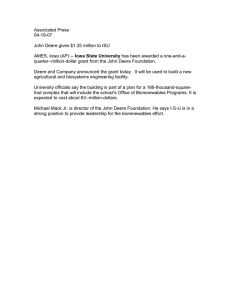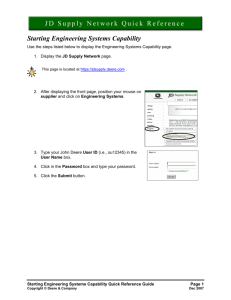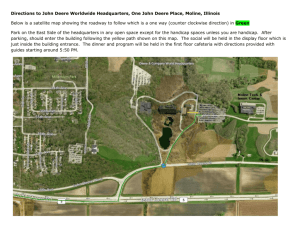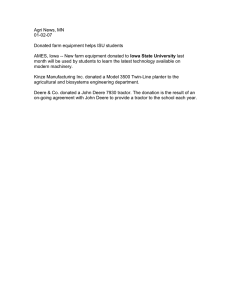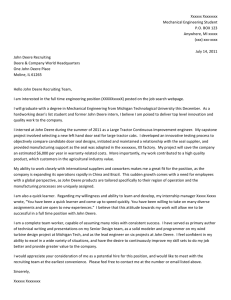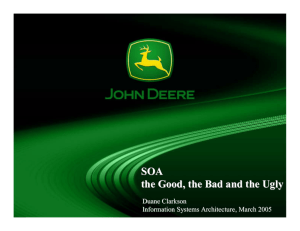Continuous Process Improvement at Deere & Company
advertisement
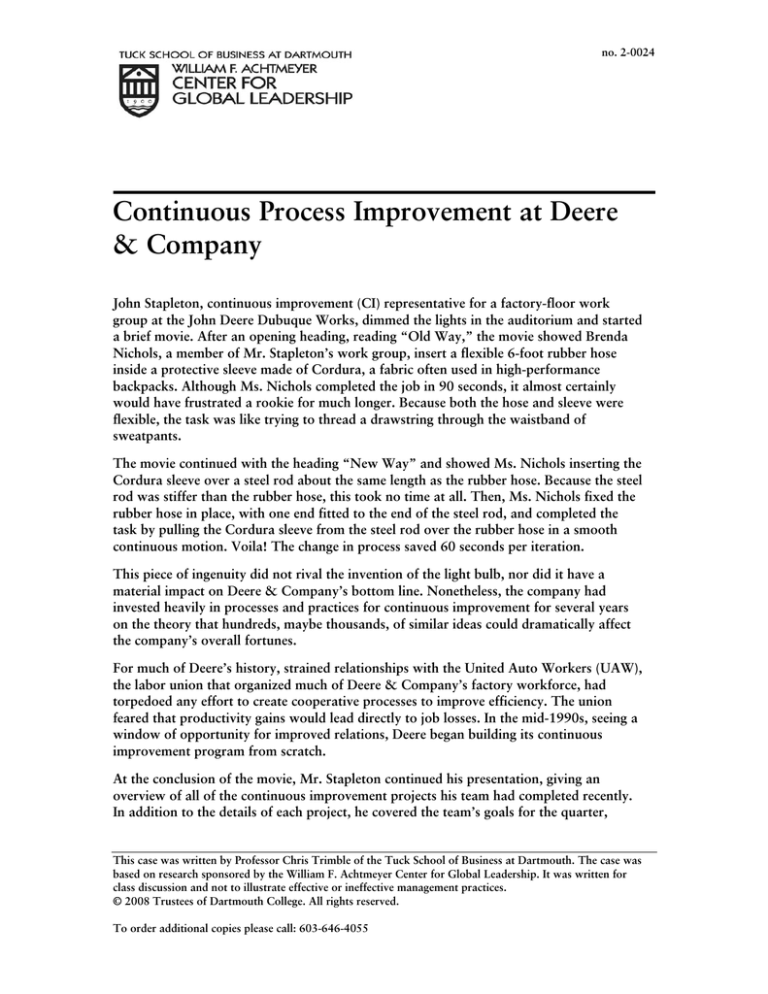
no. 2-0024 Continuous Process Improvement at Deere & Company John Stapleton, continuous improvement (CI) representative for a factory-floor work group at the John Deere Dubuque Works, dimmed the lights in the auditorium and started a brief movie. After an opening heading, reading “Old Way,” the movie showed Brenda Nichols, a member of Mr. Stapleton’s work group, insert a flexible 6-foot rubber hose inside a protective sleeve made of Cordura, a fabric often used in high-performance backpacks. Although Ms. Nichols completed the job in 90 seconds, it almost certainly would have frustrated a rookie for much longer. Because both the hose and sleeve were flexible, the task was like trying to thread a drawstring through the waistband of sweatpants. The movie continued with the heading “New Way” and showed Ms. Nichols inserting the Cordura sleeve over a steel rod about the same length as the rubber hose. Because the steel rod was stiffer than the rubber hose, this took no time at all. Then, Ms. Nichols fixed the rubber hose in place, with one end fitted to the end of the steel rod, and completed the task by pulling the Cordura sleeve from the steel rod over the rubber hose in a smooth continuous motion. Voila! The change in process saved 60 seconds per iteration. This piece of ingenuity did not rival the invention of the light bulb, nor did it have a material impact on Deere & Company’s bottom line. Nonetheless, the company had invested heavily in processes and practices for continuous improvement for several years on the theory that hundreds, maybe thousands, of similar ideas could dramatically affect the company’s overall fortunes. For much of Deere’s history, strained relationships with the United Auto Workers (UAW), the labor union that organized much of Deere & Company’s factory workforce, had torpedoed any effort to create cooperative processes to improve efficiency. The union feared that productivity gains would lead directly to job losses. In the mid-1990s, seeing a window of opportunity for improved relations, Deere began building its continuous improvement program from scratch. At the conclusion of the movie, Mr. Stapleton continued his presentation, giving an overview of all of the continuous improvement projects his team had completed recently. In addition to the details of each project, he covered the team’s goals for the quarter, This case was written by Professor Chris Trimble of the Tuck School of Business at Dartmouth. The case was based on research sponsored by the William F. Achtmeyer Center for Global Leadership. It was written for class discussion and not to illustrate effective or ineffective management practices. © 2008 Trustees of Dartmouth College. All rights reserved. To order additional copies please call: 603-646-4055 Continuous Process Improvement at Deere & Company no. 2-0024 performance against those goals, projects that were in progress but not complete, and planned projects. The occasion was the quarterly CI X Change, and more than 100 Deere employees attended. Several similar presentations followed that of Mr. Stapleton. Over the course of four CI X Changes each quarter, presentations were given by every department at the Dubuque Works, a factory that turned out many of the products offered by Deere’s construction and forestry division, including backhoe loaders, crawlers, skid steers, tracked feller bunchers, and log loaders. Every Deere factory held CI X Changes, each with the tagline “Earning the Right to GROW.” The gatherings frequently attracted people from other factories who voluntarily traveled, sometimes from other countries, to take advantage of the opportunity to gain insights from peers. The “Old Way/New Way” movies conveyed real work, featuring concrete and steel, the omnipresent Deere green and yellow paint, work boots and blue jeans, and the bangs, clangs, buzzes, and roars of the factory floor. Particularly spirited CI teams augmented their films with music and video clips. One used a Star Wars theme, another a Bugs Bunny theme. A third film, about a project that eliminated the need to bang on a large metal pin with a sledgehammer, choreographed action to Peter Gabriel’s song “Sledgehammer.” Several showed the “Old Way” of doing things in black and white, “New Way” in color. Improving Labor Relationships Deere & Company faced challenging business conditions throughout the 1980s. The farm economy in the United States sagged so severely that few farmers could contemplate large capital investments in new equipment. Meanwhile, the UAW, headquartered in Detroit and aligned primarily with the interests of workers in the automotive industry, wielded fearsome power through pattern bargaining and aggressive strikes. After a strike of nearly six months in 1987, a weakened management team at Deere conceded to union demands. H.J. Markley, who, by 2006, was president of the agricultural division, recalled, “Back then, a strike was like going to war. To get out of a strike quickly, you had to know your enemy and understand their hot buttons. To avoid strikes altogether, you had to deal with problems before there was a crisis.” Over the next decade, Deere executives routinely decided to outsource to avoid the high cost of putting workers on the factory floor. At one point, management plotted a graph of union employees over time and demonstrated that if the outsourcing continued, there would be no union employees left at Deere within two decades. This, in combination with fears associated with globalization and industry consolidation, bought Deere some credibility with the union. As a result, union leaders and Deere executives worked together to develop a more cooperative relationship. Executives began sharing much more information with unions, far beyond the norm. The two sides struck a landmark deal in the mid-1990s. For the first Tuck School of Business at Dartmouth – William F. Achtmeyer Center for Global Leadership 2 Continuous Process Improvement at Deere & Company no. 2-0024 time, Deere factories operated on a pay plan that established continuous improvement as a baseline expectation. Mr. Markley reflected, “We were fortunate to strike that deal and lucky that the two lead negotiators had been point and counterpoint in a variety of positions for four decades. They knew each other, respected each other, and trusted each other.” In accordance with the new plan, Deere measured the productivity of “natural work groups” (about 10 people to a team on average, though team size could be as low as two) and paid a bonus each pay period in proportion to production in excess of a set benchmark. Every team member received the same bonus. (Pay could also be reduced for production below the benchmark, up to a limit.) Every six months, in exchange for the bonus, the company raised the benchmark by an agreed-upon fraction of the productivity gain the team had delivered over the previous six months. The rate at which the benchmark could increase was capped at 6.5 percent for a six-month period. Following the adoption of the new pay plan, Deere’s rate of productivity improvement increased. The new pay plan was not mandatory, however, and not every work group adopted it. Some were skeptical of management’s agenda and unconvinced by arguments that Deere’s competitiveness was slipping. Nonetheless, more teams adopted the pay plan when they began to see that it delivered not only improvements in productivity but also improvements in safety and working conditions. Still, some groups declined to participate. While the bonuses looked attractive, they also tied a group to rising expectations. Other groups adopted the plan but later experienced a backlash. In fact, some frontline supervisors covertly held votes within their groups to decide whether the group would make an effort to improve performance. Many groups settled into a comfortably slow rate of improvement—enough to demonstrate a minimal commitment to continuous improvement but far from full potential. In addition to witnessing how the pay plan created mixed incentives, both management and labor began to recognize that an effective continuous improvement program demanded much more than an improved pay structure. It was a much broader changemanagement problem. Mr. Markley elaborated: In 2000, we invited Jim Hecker, a senior union leader, into the boardroom. He shook things up by pointing out that the management team at the local level was not demonstrating a full commitment to continuous improvement. He was right. The fact that we were able to have such a frank discussion without defensiveness was a strong sign of an improving relationship. Soon after, the management team promoted Brad Morris from manufacturing and quality manager to director of industrial relations. Mr. Morris had demonstrated an ability to rise above the fray and move tense relationships forward. He and Mr. Hecker led a management-labor partnership, in the form of a joint task force, to design a more complete organizational approach to continuous improvement. The task force created Tuck School of Business at Dartmouth – William F. Achtmeyer Center for Global Leadership 3 Continuous Process Improvement at Deere & Company no. 2-0024 project-planning processes, measurement and analysis tools, goal-setting mechanisms, resource allocation policies, and much more. The effort helped set the stage for a new contract in 2003, one that made continuous improvement mandatory for every Deere employee. Crucially, the new pay plan capped at 2 percent the rate at which production benchmarks could rise each six months. Deere’s management team argued that the standard was imminently reasonable, bolstering their stance with several decades of productivity data for the U.S. manufacturing sector as a whole. Both sides were comfortable viewing the 2 percent cap as consistent with a “gain-sharing” philosophy. If Deere’s factory teams could exceed the 2 percent benchmark every six months—and many felt that they could—then their pay would keep rising. In addition, the 2003 pay plan gave management more flexibility to reduce the size of the workforce during industry downturns so that the company could remain competitive through down cycles. Only a small fraction of the workforce, employees with the longest tenure, could claim some sense of job security, and even they could be temporarily laid off for up to 10 weeks per year. The lack of job security established a second incentive for the workforce to improve. The more competitive Deere & Company was, the more likely it would grow and add additional jobs. Elements of the CI Program Overall Philosophy The joint task force identified four philosophical cornerstones that set the foundation for the CI program: 1. Joint leadership. Labor and management jointly managed the CI program. 2. Organizational structure. CI efforts were led by a hierarchy of three kinds of joint teams in each factory: one CI Steering Committee, which included senior factory leaders; JD GROW teams; and CI GROW teams. 3. Methodology. The program included a methodology, analytical toolbox, and planning process for making ongoing project management routine and increasing the probability of each project’s success. 4. New profitable work. The overarching program objective was generating new, profitable work for Deere. All CI projects fell into one of four categories: safety, quality, delivery, and efficiency. The company expected that even projects not in the efficiency category would increase efficiency as a secondary effect. For example, a project that reduced the incidence of injury Tuck School of Business at Dartmouth – William F. Achtmeyer Center for Global Leadership 4 Continuous Process Improvement at Deere & Company no. 2-0024 would lead to the most experienced workers being on the job more often, and that would improve efficiency. A project that increased quality eliminated the necessity of rework, and that also improved efficiency. Ongoing Process Frontline employees generated ideas for CI projects. Inspiration often came from experience and intuition, though there were also formal processes, such as safety audits, that produced ideas. In addition, CI leadership groups initiated “gap analysis” projects each quarter to help teams discover the root causes of disparities between current performance and goals. Projects ranged in size. If a project could be tackled by one person in a few hours, it was best to just do it rather than formalize it as a CI project. On the high end, CI projects occasionally went so far as to tackle major improvements, such as rearranging production lines, but this was rare. The scope of projects was limited by the reality that work groups implemented CI projects on the job while keeping up with the demands of customer orders and production schedules. Once per quarter, each natural work group prioritized the projects it had identified and made commitments for the upcoming three months. CI GROW teams, which included CI representatives from several related natural work groups plus labor supervisors and manufacturing engineers, worked with each natural work group in developing their plans. As part of the planning process, CI GROW teams could request funding for projects from JD GROW teams. JD GROW teams included factory manufacturing management and local union leadership and made allocations of up to $50,000 routinely. CI projects occasionally attracted even more funding, but such outlays came with the caveat that some of the productivity gain would accrue to the company, not to labor. Occasionally, ideas with roots in the CI program would lead to small, non-engineering-intensive improvements in product design. There were regular meetings between manufacturing and product development teams to facilitate the transfer of such inspirations. In addition, as part of their quarterly plans, natural work groups proposed goals for each of the four core measures of safety, quality, delivery, and efficiency. The CI leadership group also established goals for factories as a whole. Deere’s CI philosophy was that goal setting should take place as close to the front line as possible, but at least some negotiation inevitably followed. As a minimum standard, the company required every natural work group to tackle at least four CI projects per quarter—one each in the categories of safety, quality, delivery, and efficiency. That established an expectation that not doing CI was never an option; it was a requirement. Every Deere employee had some downtime on the job—when their machines were down for maintenance, when an upstream production step was delayed, etc.—and thus every employee could contribute to the CI program. Tuck School of Business at Dartmouth – William F. Achtmeyer Center for Global Leadership 5 Continuous Process Improvement at Deere & Company no. 2-0024 Few teams operated at this minimum standard, however. The CI leadership groups sought to establish goals that were challenging but achievable. They relied on a number of benchmarks to shape their intuition regarding the numbers that corresponded to this philosophical guideline. For example, they examined the following: 1. Historical trends in safety, quality, delivery, and efficiency, adjusted for seasonality. The company was able to complete many more CI projects during slow seasons. 2. Overall success rates. The CI leadership groups sought to ensure that most teams succeeded in reaching most of their goals, fearing that if too many teams perceived they were underperforming it would undermine the program. Specifically, they tried to adjust goals so that at least 50 percent of the teams hit at least three of their four goals each quarter. Frequently, the CI oversight groups felt it was necessary to reduce goals that the aggressive, high-bonus-seeking natural work groups proposed to keep success rates at levels that perpetuated enthusiasm towards the program. 3. Results from other teams and other factories. This information was readily available. In fact, each factory published a CI report card, detailing the performance of every group in the factory and rating teams on a scale of one to four. All factories reported the same core metrics. However, the company downplayed competition among teams and factories because competition could reduce the motivation to share ideas and was inconsistent with a philosophy of creating more winners than losers. Once plans were approved, CI representatives from each natural work group published the plans in the team’s work space, and did so quite visibly. This created a sense of mutual accountability within the team. If one part of the team was making progress while another dragged behind, the faster-moving group would likely exert some pressure on their slowermoving teammates. CI GROW teams also formally reviewed the progress of each natural work group twice per month. Figure 1, a graphical depiction of the CI process, was published widely within Deere & Company. Each quarter, the company tackled thousands of CI projects. Deere considered any completed project a success. Not all were completed. Some turned out to be more complex than anticipated or suffered delays because they required more collaboration with other groups within the factory than was originally anticipated. There were also a few teams that routinely underperformed, as there would be in any company. Some of these teams claimed they were understaffed and had no time for CI because of the demands of everyday business. Some suffered from poor leadership. Others simply were unable to overcome hostilities rooted in decades of tension between labor and management. Overall, however, leaders from both labor and management were exceedingly pleased with the results. Figure 2 shows the rapid acceleration in the number of CI projects completed annually between 2003 and 2006. Figure 3 shows productivity gains between 2004 and Tuck School of Business at Dartmouth – William F. Achtmeyer Center for Global Leadership 6 Continuous Process Improvement at Deere & Company no. 2-0024 2006, and Figure 4 indicates pay increases between 2003 and 2006. Deere & Company makes some corrections in aggregate productivity measures before calculating pay. These include a correction for disruptions caused by the introduction of new products and processes and a correction for time allocated to such activities as training and new employee orientation. Management Support The CI leadership teams all viewed their primary role as increasing the probability of success for each natural work group. CI GROW teams helped each natural work group plan and prioritize. They also helped conduct gap analyses to identify opportunities each quarter, introducing tools such as variance analysis, Pareto analysis, fishbone diagramming, cycle-time analysis, value-stream mapping, and cost-benefit analysis. One CI leader reflected, We have some deep-process experts around here. Some of them have been around here for 30 years and think that they already understand most everything there is to know about the production processes they are a part of. Nonetheless, we find that these analytical tools point us in new directions. The JD GROW teams contributed by providing resources, connecting teams to other groups that needed to make a contribution for a project to succeed, and removing obstacles that prevented projects from reaching conclusion. They also formally recognized each employee who was part of a natural work group that met three of their four quarterly CI goals. The CI Steering Committees in each factory, in partnership with a national joint committee, sought to ensure that the direction of the CI program aligned with company goals. These committees also maintained a positive overall CI culture. Gail Leese, the general manager of the Davenport Works, elaborated: I constantly remind people that innovation comes in many shapes, sizes, and colors. It is not always a new thing that you hold in your hands. It can be an improvement in material flow, a reorganization of a work space, an improvement to safety. I also reinforce the value of small ideas and encourage people to spread their ideas to other teams. In addition, when customers tour the facility, I encourage them to talk to anyone on the floor. That leads to a stronger affinity between business and employees. Our orientation of new employees always focuses on customers and alerts them to the fact that they could meet a customer at any time. Deere also created extensive training tools. For example, the company created training videotapes and customized them for each factory. In each, a senior union representative from the factory appeared alongside the plant’s general manager. Videos typically showed the products that the factory produced alongside those that competitors produced. Tuck School of Business at Dartmouth – William F. Achtmeyer Center for Global Leadership 7 Continuous Process Improvement at Deere & Company no. 2-0024 CI leadership teams also found as many ways as they could to accelerate the transfer of ideas between teams and between factories. CI coordinators from each factory met monthly for this purpose. The CI X Changes served as another important mechanism for knowledge sharing, and the leadership teams went out of their way to alert teams from other factories to presentations that might interest them. People’s willingness to travel long distances to attend CI X Changes inspired CI leaders. “It is a powerful way to engage the workforce, much more so than we anticipated,” commented one CI leader. “People are naturally curious about what other teams are doing.” As a result, the company began investing in information systems to catalog CI projects and make them accessible to anyone in the company. Results Deere & Company sustained growth in the early 2000s while many industrial companies in the heartland of the United States struggled. Many analysts attributed a significant slice of the company’s overall success to continuous improvement efforts. Some Deere executives believed the depth of the labor-management partnership was unprecedented. Mr. Morris described the environment as the “best labor-management alignment we’ve ever had in my career.” Mr. Markley elaborated: I’ve never run into any other company with a UAW affiliation that says they have a better relationship than Deere does. The reason we have a good relationship is that we have consistently given the union straight answers. We’ve developed personal relationships and trust. As we look to the next renegotiation with the union in 2009, we know there will be a full agenda, but the continuous improvement program will not be on it. It is working very well. CI leaders noted that more and more CI teams were engaged in the process each year, including some that had actively hidden from the process earlier. Managers were more engaged as well. Teams were working harder and feeling more pride in their work. Anecdotes describing situations in which frontline workers had wanted to make a specific improvement for years and finally had seen the project through under the CI program were common. Some CI leaders wondered whether the results were sustainable. CI’s guiding philosophy was that many small improvements were more important than home runs. Would the company eventually run out of smaller projects and face the necessity of taking on bigger projects and bigger risks? Mr. Markley responded: That is a good question. We have not yet run out of small ideas. Even if we do run out, we should be able to tackle bigger projects, provided that we can keep the spirit of trust and cooperation going and avoid politicizing the factory floor. Tuck School of Business at Dartmouth – William F. Achtmeyer Center for Global Leadership 8 Continuous Process Improvement at Deere & Company no. 2-0024 Nonetheless, management was pleased with the rate of productivity improvements, and workers were pleased with their paychecks, which were higher than they had ever been. As important as the improved pay structure was, Mr. Ken Huhn, Deere’s vice president of industrial relations, believed the employees’ ownership of the CI process was equally important. Speaking for the labor-management partnership, he explained: We own the pay plan and the CI process. I’m proud to say that we designed it ourselves. We learned from experience that you cannot get full employee engagement when you work with outside experts. Ours may not be the best system, but we understand it, it fits our culture, and we own it, and that goes a long way on the factory floor. Tuck School of Business at Dartmouth – William F. Achtmeyer Center for Global Leadership 9 Continuous Process Improvement at Deere & Company no. 2-0024 Figure 1: Tuck School of Business at Dartmouth – William F. Achtmeyer Center for Global Leadership 10 Continuous Process Improvement at Deere & Company no. 2-0024 Figure 2: Tuck School of Business at Dartmouth – William F. Achtmeyer Center for Global Leadership 11 Continuous Process Improvement at Deere & Company no. 2-0024 Figure 3: Tuck School of Business at Dartmouth – William F. Achtmeyer Center for Global Leadership 12 Continuous Process Improvement at Deere & Company no. 2-0024 Figure 4: Tuck School of Business at Dartmouth – William F. Achtmeyer Center for Global Leadership 13
